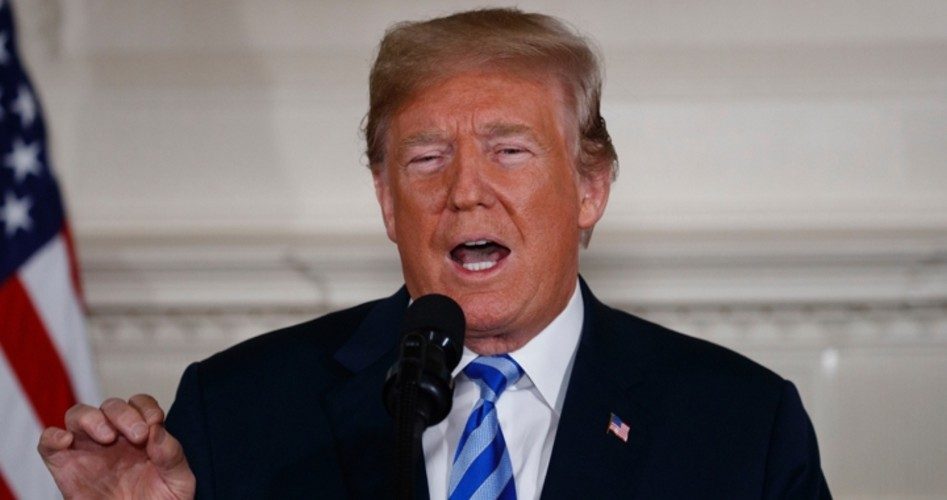
Having signed into law a $1.3 trillion spending package earlier this year, President Donald Trump is now seeking to recoup $15 billion in previously allocated, but unspent, outlays.
On Tuesday, Trump sent Congress a request to recover, among other things, $7 billion from the Children’s Health Insurance Program (CHIP), $4.3 billion from a vehicle-technology loan program, $800 million from an ObamaCare “innovation” program, over $200 million from an anti-Ebola program, $133 million from an expired railroad unemployment program, and $107 million in Hurricane Sandy relief.
The request, known as a rescission, was submitted under a 1974 law that requires the president to spend all monies appropriated by Congress unless he gets congressional approval to withhold some of it. After the president submits a rescission, Congress has 45 days to act on it before it expires. In the meantime, the funding in question is frozen. If a simple majority of both houses votes for the rescission, it takes effect; it cannot be filibustered. In addition, Congress may reduce the amount of the rescission.
Congress often passes its own rescissions, usually to reallocate funds to other priorities. Presidential rescissions, while quite common in the 20th century, have been absent since the waning days of the Clinton administration. The administration claims Trump’s rescission is the largest ever submitted by a president. According to Vox, “Senior officials say Trump’s rescission package is different from Congress’s in that it won’t be used to ‘justify higher spending’ elsewhere.”
The administration thinks Trump’s request is noncontroversial, seeing as how the money wasn’t likely to be spent anyway. For instance, of the $7 billion CHIP rescission, $5 billion is in an account the president no longer is authorized to disburse. The remaining $2 billion is in a contingency fund to help states that experience higher-than-expected enrollment, but at this point in the year no state seems likely to need it. The Hurricane Sandy relief, meanwhile, can only be spent if local governments match it, but none has done so in the six years since the storm.
In Washington, however, even seemingly noncontroversial policies can become occasions for political grandstanding, and such is the case with Trump’s rescission. While it is expected to sail through the House of Representatives, its fate in the Senate, where Republicans hold a one-seat majority, is less certain.
Democrats, and even some Republicans, have raised a stink about the CHIP cuts, notwithstanding the fact that they don’t affect any child’s healthcare. Senate Minority Leader Chuck Schumer (D-N.Y.) said in a statement that Trump and congressional Republicans “are looking to tear apart the bipartisan [CHIP], hurting middle-class families and low-income children, to appease the most conservative special interests and feel better about blowing up the deficit to give the wealthiest few and biggest corporations huge tax breaks.” Senator Susan Collins (R-Maine) told the Washington Post that she would “have to have an awfully good reason given to” her to agree to the CHIP rescission.
The Hurricane Sandy rescission is likely to meet with resistance from New York and New Jersey lawmakers, reports the Washington Times.
Senator Lindsey Graham (R-S.C.), who sits on the Senate Appropriations Committee, told Roll Call flatly that Trump’s rescission is “going nowhere” in his chamber.
The administration hopes the rescission, if it passes, will placate conservatives who were outraged over Trump’s approval of the huge spending bill. But as Georgetown University law professor David Super points out,
The White House is, on the one hand, touting large savings from these rescissions while on the other hand insisting that they will do no harm because the money would not have been spent anyway. If the money would not have been spent, there are no savings…. Any rescission of money that would not be spent by definition cannot reduce the deficit.
Recognizing this fact, the administration is assuring conservative lawmakers that this is just the beginning of its assault on runaway spending. “All told,” writes the Post, “officials are eyeing $25 billion in cuts” — hardly a blitzkrieg on Uncle Sam’s profligacy.
If the president is having trouble determining what other spending should be cut, he need only peruse the document he has sworn to “preserve, protect and defend”: the U.S. Constitution.
Photo: AP Images



